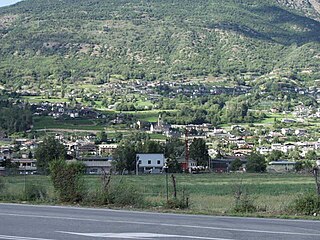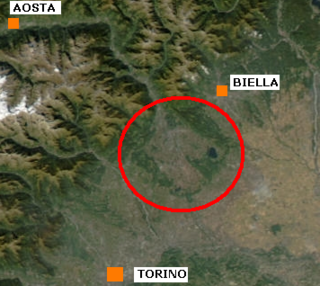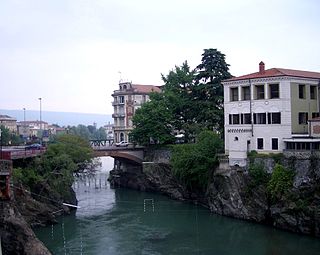
Aosta is the principal city of the Aosta Valley, a bilingual region in the Italian Alps, 110 km (68 mi) north-northwest of Turin. It is situated near the Italian entrance of the Mont Blanc Tunnel and the Great St Bernard Tunnel, at the confluence of the Buthier and the Dora Baltea, and at the junction of the Great and Little St Bernard Pass routes.

Ivrea is a town and comune of the Metropolitan City of Turin in the Piedmont region of northwestern Italy. Situated on the road leading to the Aosta Valley, it straddles the Dora Baltea and is regarded as the centre of the Canavese area. Ivrea lies in a basin that in prehistoric times formed a large lake. Today, five smaller lakes—Sirio, San Michele, Pistono, Nero and Campagna—are found in the area around the town.

Saint-Christophe is a town and comune in the Aosta Valley. It is located east of Aosta, on the left shore of the Dora Baltea.

Doire was a department of the French Consulate and of the First French Empire in present-day Italy. It was named after the river Dora Baltea. It was formed in 1802, when the Subalpine Republic was directly annexed to France. Its capital was Ivrea.

Dora Baltea or Doire Baltée is a river in northwestern Italy. It is a left-hand tributary of the Po and is about 170 kilometres (110 mi) long.

Associazione Sportiva Dilettantistica Calcio Ivrea commonly referred to as A.S.D. Calcio Ivrea or simply Ivrea is an Italian association football club, based in Ivrea, Piedmont that plays in the regional Eccellenza.

Bard is a town and comune in the Aosta Valley region of northwestern Italy. It is part of the Unité des communes valdôtaines du Mont-Rose and has a population of 134. It is one of I Borghi più belli d'Italia.

Pont-Saint-Martin ; Piedmontese: Pont San Martìn) is a town and comune in the Aosta Valley region of northwest Italy.

The 4th Alpini Paratroopers Regiment is a special operations forces regiment of the Italian Army based in Montorio Veronese in Veneto. Originally the regiment belonged to the Italian Army's Alpini infantry specialty, but since 14 July 1996 its personnel also belongs to the Paratroopers infantry specialty. On 1 November 1882, the Royal Italian Army formed the 4th Alpini Regiment, which had its recruiting area in the Graian Alps and Pennine Alps. Since 2013 the regiment is assigned to the Army Special Forces Command. The regiment is one of the most often and one of the highest decorated regiments of the Italian Army, although its two Gold Medals of Military Valor were awarded to the regiment's currently inactive Alpini Battalion "Aosta", respectively the currently active Battalion "Monte Cervino".
The Salassi or Salasses were a Gallic or Ligurian tribe dwelling in the upper valley of the Dora Baltea river, near present-day Aosta, Aosta Valley, during the Iron Age and the Roman period.

The Buthier is a mountain torrent in north-west Italy. A left bank tributary of the Dora Baltea, its entire course lies within the Valpelline, a valley in the region of Aosta Valley.

Fort Bard, also known as Bard Fort, is a fortified complex built in the 19th century by the House of Savoy on a rocky prominence above Bard, a town and comune in the Aosta Valley region of northwestern Italy. Fort Bard has been completely restored after many years of neglect. In 2006 it reopened to tourists as the Museum of the Alps, it has additional art exhibitions and galleries. In the summer, the main courtyard is used to host musical and theatrical performances.
Ponte Vecchio may refer to:

Sarriod de la Tour Castle is a castle in the town of Saint-Pierre by the Dora Baltea River, in Northwestern Italy's Aosta Valley. The original castle was typical of the style built between the 10th and 12th centuries, and was greatly expanded by Jean Sarriod in 1420 and his son, Antoine, in 1478. The north wing's ground floor features a wooden-ceilinged "Hall of Heads", named for its decorative motifs.

Ivrea railway station is the train station serving the town and comune of Ivrea, in the Piedmont region of northwestern Italy. It is the junction of the Chivasso–Aosta railway.

The Chivasso–Ivrea–Aosta railway is a railway line that links the regions of Piedmont and Aosta Valley in Italy. It was inaugurated from 1858 to 1886. The railway was operated by the Italian Armys Ferrovieri Engineer Regiment from 1915 to 1943 and 1949 to 2001.

The Ponte Vecchio is a stone and brick arch bridge over the Dora Baltea in Ivrea, Italy.

The Ivrea Morainic Amphitheatre is a moraine relief of glacial origin located in the Canavese region. Administratively, it encompasses the metropolitan city of Turin and, more marginally, the province of Biella and the province of Vercelli. It dates back to the Quaternary period and was created by the transport of sediment to the Po Valley that took place during the glaciations by the great glacier that ran through the Dora Baltea valley. With an area of more than 500 km2, it is one of the best-preserved geomorphological units of this type in the world. As an extension, it is surpassed in Italy only by the similar formation surrounding Lake Garda. The name amphitheater, usually given to these geomorphological structures, refers to their characteristic elliptical shape that is noticeable when it is shown as a plan on a map.

The Ponte Nuovo is an arch bridge over the Dora Baltea in Ivrea, Italy.

The Camillo Olivetti Fountain is a memorial fountain located in Ivrea, Italy.


















